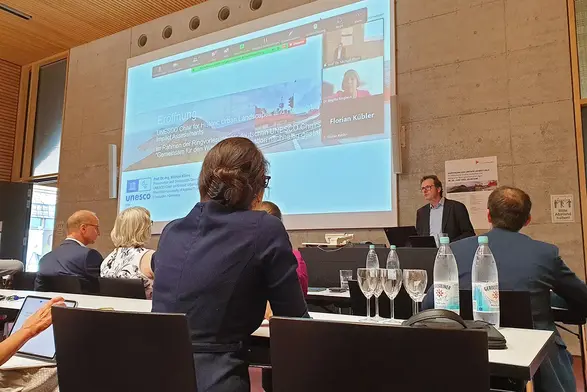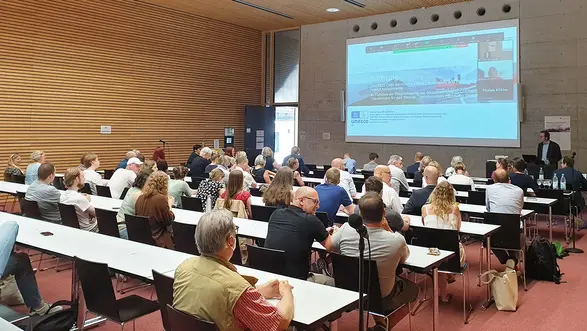Opening of UNESCO Chair


"Enormous enhancement of the degree program, faculty and university"
Wiesbaden, July 01, 2022 - Following its establishment in April 2022, the UNESCO Chair for Historic Urban Landscapes and Cultural Heritage Impact Assessment at Hochschule RheinMain (HSRM) was officially opened yesterday evening. As part of a lecture series hosted by the German Commission for UNESCO (DUK) to mark the 30th anniversary of the UNESCO Chair program, Chair holder Prof. Dr. Michael Kloos gave a lecture on the topic of conservation and sustainable transformation of historic urban landscapes in the UNESCO World Heritage.
Prior to this, Prof. Dr. Eva Waller expressed her delight in a welcoming address: "It is at least as great as yours, Mr. Kloos. I would therefore like to thank everyone who was involved in setting up this chair," said the university president. "It is great to further increase the visibility of our university in this way - regionally, nationally and internationally - and we can be very proud to be the first university of applied sciences with a UNESCO Chair."
The Dean of the Faculty of Architecture and Civil Engineering, where the chair is based, was also enthusiastic. "The UNESCO Chair is a huge boost for the degree program, the faculty and the university. It is a unique selling point and provides new impetus in teaching, research and transfer," said Prof. Dr. Robert Kanz. Congratulations also came from Dr. Birgitta Ringbeck, Head of the World Heritage Coordination Office at the Evaluation Office, who had joined the ceremony from Berlin and has been working with Prof. Dr. Kloos for many years. He is now receiving the recognition he deserves as part of the UNESCO Chair.
Network welcomes new additions
Dr. Marlen Meißner, Head of the Heritage, Nature, Society division, spoke on behalf of the DUK that evening, highlighting the importance of the UNESCO Chair program in her welcoming address. In this context, the new chair at the HSRM is a "meaningful and profitable expansion of the network" and makes "a concrete contribution to the central efforts of UNESCO". Prof. Dr. Alexander Siegmund, spokesperson for the network of German UNESCO Chairs, sent a digital greeting at the end of the first part. He was delighted to welcome the HSRM to the family of UNESCO Chairs.
In a presentation, Prof. Dr. Kloos then highlighted the central aspects of his chair and gave an insight into his working methods. "Preserving historic urban landscapes responsibly and developing them sustainably is a major task in view of the high pressure to change," said Prof. Dr. Kloos. Urban landscapes worthy of protection are endangered by traffic infrastructure measures, for example, but also by wars, as the example of the ancient city of Palmyra in Syria shows.
Impact assessments as an important tool
Prof. Dr. Kloos made the link to impact assessments using the example of Cologne Cathedral, which has been a UNESCO World Heritage Site since 1996. A major construction project - an ICE high-rise cluster on the right bank of the Rhine - prompted UNESCO to include the cathedral on its Red List of World Heritage in Danger in 2004, which is why the city of Cologne commissioned a so-called Visual Impact Study. The results of this examination, for which Prof. Dr. Kloos was responsible, ultimately prompted the city to reject the project. As a direct result, UNESCO removed the cathedral from the list in 2006.
"Just like the debate surrounding the cultural landscape of the Dresden Elbe Valley, which was removed from the World Heritage List in 2009, the example of Cologne Cathedral has shown the high emotional value of UNESCO World Heritage Sites and how important it is to protect them," emphasized Prof. Dr. Kloos.
In the final part of his lecture, Prof. Dr. Kloos finally addressed the importance of the chair for research and teaching and presented examples of bachelor's and master's theses from the Architectural Heritage and Architectural Heritage | Building in Historic Context degree programs as well as current dissertation projects.